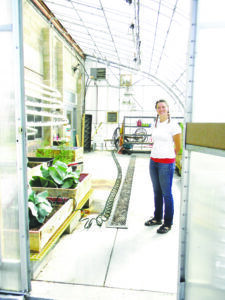Farm to School Programmer Shayla Smith has been working hard for the past year trying to introduce both students and staff at Darby school to the concept of eating fresh, locally grown foods and she’s having some success. The local program is the result of a successful grant application for $28,000 from the U.S. Department of Agriculture. The money was primarily spent on paying Smith’s salary and sending her to the National USDA Farm to School event where she met with people from schools across the nation where the program is being implemented.
According to Darby School District Clerk Lisa Poe, who made the successful grant application, shifting people’s eating and cooking habits is a little bit of a hard sell. Not only do the students have to be enticed into trying something new, but the kitchen staff is faced with a lot more work as they take a step backward, in a sense, and return to making things from scratch rather than slapping prepared and processed foods into the microwave. Although fresh local food can be less expensive than processed foods, more time and labor is put into preparing the fresh food from scratch.
“It’s a paradigm change,” said Poe. “When we started they didn’t even have a potato peeler in the kitchen or even any real potatoes.”
“The kitchen staff sees it as a lot more work,” said Smith. As a result she has spent a good bit of time herself in the kitchen helping out. Smith also tends the greenhouse where some fresh vegetables are grown on campus.
Education is the key to transitioning to the “buy local, buy fresh” philosophy, according to Smith. One way to initiate change is to give the kids an opportunity to taste the difference. They get this in the lunchroom at the Try It Table, where selections of fresh vegetables and fruits are made available with no stigma attached if you need to spit it out.
“It’s worked,” said Smith. “The kids are trying it and they can taste the difference.” Once a week, on Montana Monday, the students are given the option of choosing local dishes for their whole meal instead of the standard fare.
The students are also involved in growing some native plants from seeds. Some are edible, some medicinal and some are just beautiful. The plants are grown in raised beds constructed for this purpose and painted with designs by the students themselves. The students have also gotten lessons in preserving food by canning and pickling.
Food Director Thong Robbins said she is trying hard to incorporate the Farm to School concept into the lunchroom. She makes soup from scratch and has an excellent salad bar, she said. She also features a “vegetable of the month” to encourage the kids to try it.
“It’s working,” said Smith. She said the kids did a taste test and ate a regular carrot from the store, an organic carrot, and a fresh carrot from the greenhouse. “They can taste the difference,” said Smith.
As grant funds are running out both Smith and Poe hope that the program can be continued and perhaps expanded in the coming years.

